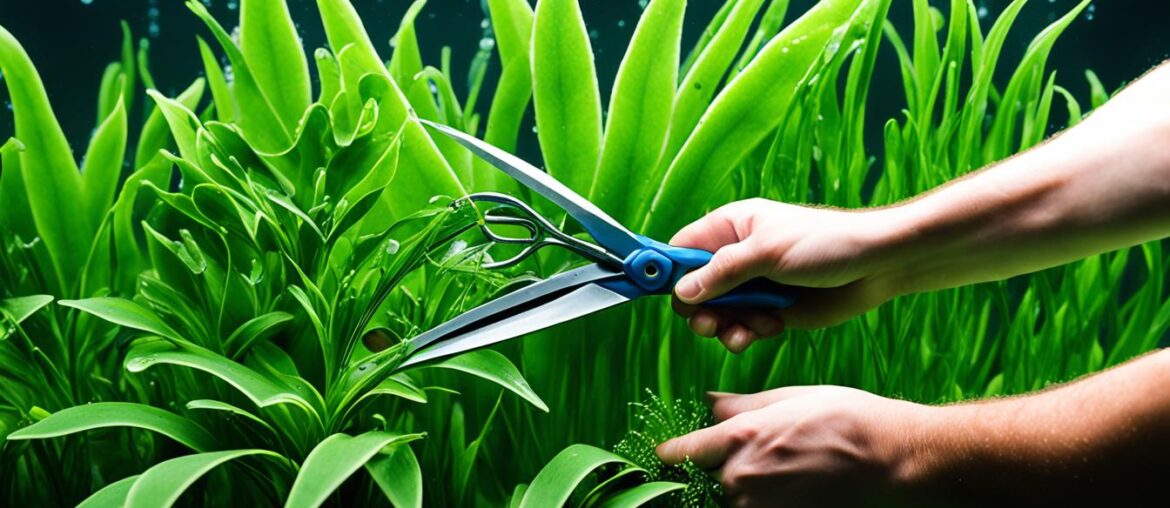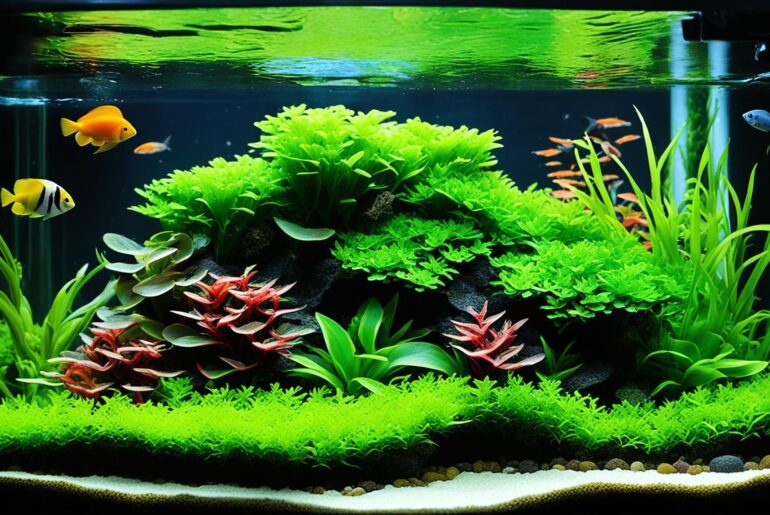Imagine stepping into a mesmerizing underwater world, filled with vibrant colors and lush vegetation. The gentle sway of aquatic plants creates a serene and enchanting atmosphere, captivating both you and your aquatic pets. But maintaining a thriving aquarium garden requires more than just a touch of nature’s beauty. It demands dedication, knowledge, and the art of trimming.
As an avid aquarist, I understand the joy and fulfillment that comes from tending to a flourishing underwater garden. I have spent countless hours meticulously trimming and shaping my aquarium plants, discovering the techniques that can transform a simple tank into a breathtaking aquatic masterpiece.
Today, I want to share with you my secrets to trimming aquarium plants like a pro. Whether you’re a beginner or a seasoned aquascaper, these essential steps will guide you towards achieving stunning results and creating a harmonious environment for your aquatic companions.
Key Takeaways:
- Trimming aquarium plants is crucial for the health and beauty of your underwater garden.
- Mastering the art of trimming requires knowledge and practice.
- By following these essential steps, you can transform your aquarium into a captivating aquatic masterpiece.
- Regular trimming promotes healthy growth and prevents overgrowth.
- Proper care and maintenance are key to the longevity of your aquarium plants.
Trimming Rhizome Plants
When it comes to aquascaping, rhizome plants like Anubias and Java fern are popular choices due to their unique growth patterns. Understanding proper rhizome plant trimming techniques is essential to promote healthy growth and maintain the aesthetic appeal of your underwater garden.
Rhizome plants have a thick modified stem called the rhizome, from which the roots and leaves grow. It’s crucial to trim any unhealthy or rotting leaves close to the rhizome to stimulate new growth. This ensures that the plant directs its energy towards healthy foliage.
If roots become overgrown or unsightly, they can also be trimmed. Trimming the roots will not harm the plant as they primarily serve as anchors. Simply use sharp scissors or a razor blade to prune any excessive roots, enhancing the overall appearance of your aquascape.
Another important aspect of rhizome plant trimming is the removal of rotting or dying sections of the rhizome itself. Cutting off these damaged portions prevents further decay and potential harm to the entire plant.
Propagating rhizome plants is relatively simple. To propagate, carefully cut the rhizome with sharp scissors or a razor blade, ensuring that each division has healthy leaves and roots. These new plant cuttings can be replanted in your aquarium or shared with other aquascaping enthusiasts.
Overall, mastering rhizome plant trimming techniques is vital for maintaining the health and appearance of these beautiful aquatic plants. Regular trimming helps promote new growth, prevents decay, and ensures that your aquascape remains vibrant and visually appealing.
Trimming Stem Plants
Stem plants, such as Rotala and Ludwigia, are known for their captivating colors and bushy growth patterns. To ensure the healthy development of these aquatic plants, it is essential to practice effective stem plant trimming techniques.
When it comes to pruning aquarium stem plants, a key strategy is to trim the longest shoots just above one of the bottom leaves. This method encourages the growth of new lateral shoots from the trimmed stem, resulting in a fuller and more attractive appearance.
Moreover, by replanting the cuttings, you can potentially triple the stem count and density in your aquascape. This technique not only enhances the visual appeal of your tank but also helps create a more vibrant and lush underwater garden.
An important consideration before planting stem plants in your aquarium is to trim any emersed portions. Emersed growth refers to the part of the plant that has grown out of the water. Trimming these portions before planting prevents plant melt and ensures successful acclimation to the underwater environment.
Overall, mastering the art of pruning stem plants is crucial for maintaining a thriving aquatic habitat. With proper trimming techniques and attention to detail, you can create a stunning underwater landscape that showcases the beauty and vibrancy of stem plants.

Comparison of Stem Plant Trimming Techniques
| Trimming Technique | Advantages | Disadvantages |
|---|---|---|
| Trimming just above bottom leaves |
|
|
| Trimming emersed portions |
|
|
Trimming Mosses
Mosses, such as Java moss and Christmas moss, are versatile plants that add a lush and natural look to aquariums. To maintain their appearance and promote growth, proper trimming techniques are crucial. Here, I will guide you through moss trimming techniques and how to trim aquatic moss effectively.
Shaping Moss with Precision:
The first step in trimming moss is to identify the areas that require shaping. Using sharp scissors, carefully cut the moss to achieve the desired shape and size. Keep in mind that mosses grow slowly, so it’s essential to take your time and trim conservatively.
When trimming moss, it’s important to turn off the filter to prevent loose fragments from spreading throughout the tank. Have a siphon ready to remove any debris that may be released during the trimming process. This helps maintain water clarity and prevents clogging of the filter.
Propagating Moss from Trimmed Fragments:
One of the incredible attributes of mosses is their ability to grow from even the tiniest fragments. After trimming, you can replant these fragments to create new growth areas or attach them to desired surfaces, such as rocks or driftwood, using black thread. Over time, the attached fragments will establish and grow, creating a beautiful moss-covered surface.
Tip: Don’t discard the loose fragments of moss that you siphon out during the trimming process. Instead, use them to create additional moss-covered areas in your aquarium. You can attach them to surfaces with black thread or let them float until they attach naturally.
Mosses offer a wide range of possibilities for aquascaping, allowing you to create artistic and intricate scapes. Through regular trimming and propagating, you can maintain the desired shape and density of your mosses, ensuring a visually appealing and healthy aquatic environment.
Benefits of Trimming Moss:
Regular trimming of mosses offers several benefits, including:
- Promoting healthy growth by removing dead or decaying portions.
- Controlling the spread of moss to maintain desired dimensions.
- Creating visually appealing scapes by shaping moss to specific forms.
- Propagating moss by replanting or attaching trimmed fragments, enhancing the overall density and coverage.
By incorporating moss trimming techniques into your aquarium maintenance routine, you can enjoy the full potential of these beautiful and versatile plants.
| Benefits of Moss Trimming | How it Helps |
|---|---|
| Promoting Healthy Growth | By removing dead or decaying portions, trimming ensures the remaining moss stays healthy and vibrant. |
| Controlling Spread | Trimming allows you to maintain the size and shape of the moss, preventing overgrowth and maintaining the desired aesthetic. |
| Creating Visual Appeal | With precision trimming, you can shape the moss into artistic forms, enhancing the overall appearance of your aquarium. |
| Propagating Moss | Trimmed fragments can be replanted or attached to surfaces, leading to increased density and coverage. |
Trimming Bulb Plants
When it comes to maintaining bulb plants like Aponogeton and Crinum in your aquarium, proper trimming is essential for their health and growth. These plants have larger leaves that sprout from a bulb-like structure, creating a beautiful and dramatic display in your underwater garden.
When trimming bulb plants, the goal is to remove any old or unhealthy leaves that may be hindering the plant’s overall well-being. To do this, use sharp scissors or pruning shears to cut these leaves as close to the base as possible. By removing these dead or dying leaves, you can encourage new healthy growth and maintain the aesthetics of your aquarium.
“Remember, new leaves will not grow from the trimmed portion but will emerge from the shoot tip of the bulb.”
It’s important to note that unlike some other plants, bulbs should not be divided during the trimming process. This is because bulbs contain vital organs necessary for the plant’s survival. Dividing the bulb can cause harm and potentially lead to the plant’s decline.
By following these trimming techniques for bulb plants, you can ensure their longevity and contribute to the overall beauty of your aquatic environment.
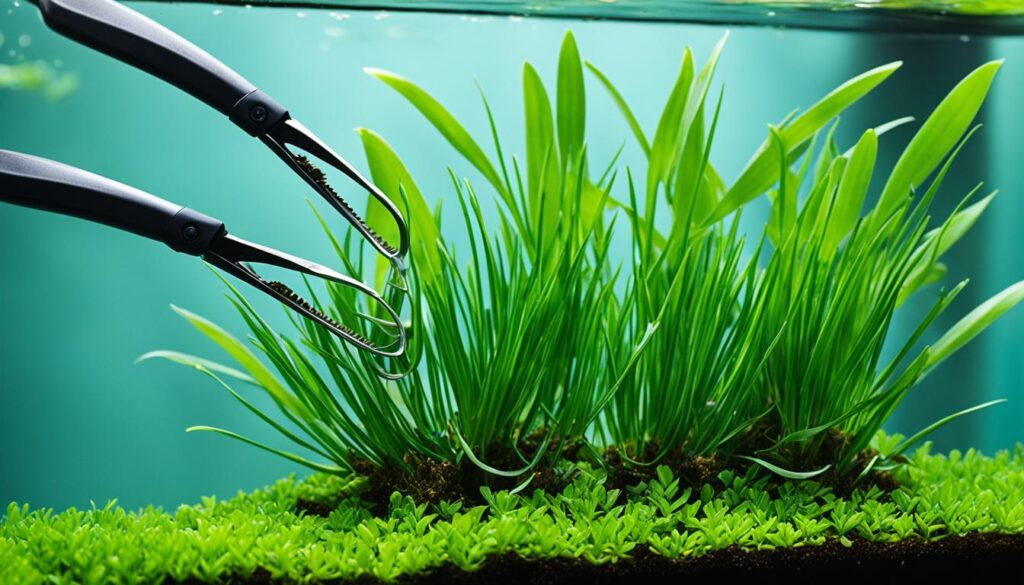
Benefits of Trimming Bulb Plants:
- Promotes new healthy growth
- Enhances the overall aesthetics of your aquarium
- Prevents the spread of diseases or pests
- Helps maintain a balanced ecosystem in your tank
Summary
Trimming bulb plants, such as Aponogeton and Crinum, is a vital aspect of maintaining a vibrant and healthy underwater garden. By removing old or unhealthy leaves, you can stimulate new growth and ensure the longevity of your bulb plants. Remember to use sharp scissors or pruning shears and cut the leaves as close to the base as possible. Avoid dividing the bulb, as it contains essential organs for the plant’s survival. With proper trimming techniques, you can enjoy a stunning display of bulb plants in your aquarium.
Trimming Rosette Plants
Rosette plants, such as Cryptocoryne and Amazon Sword, add a lush and vibrant touch to any aquarium. To maintain their health and promote new growth, proper trimming techniques are essential. By following these rosette plant trimming techniques, you can ensure the longevity and beauty of your aquatic garden.
One of the primary reasons to trim rosette plants is to remove damaged or rotting leaves. These leaves not only detract from the plant’s appearance but can also harbor diseases or pests. To effectively trim rosette plants, focus on the petiole, which is the leaf stem.
When trimming rosette plants, use sharp scissors or pruning shears to cut the petiole as low as possible. This redirects the plant’s energy towards healthier leaves and encourages new growth. Make clean and precise cuts to minimize stress on the plant.
To propagate rosette plants, a useful technique is to cut side shoots from the main plant. These side shoots can be replanted, creating new individual plants. This ensures a continuous supply of healthy rosette plants in your aquarium.
Remember to provide a nutrient-rich substrate for rosette plants, as their thick base or rhizome requires sufficient nutrients for optimal growth and development. Consider using substrate additives or specialized fertilizers specifically designed for aquatic plants.
Tip: Regularly monitoring the overall health of your rosette plants is crucial. Look out for signs of nutrient deficiencies, such as yellowing leaves or stunted growth, and adjust your care routine accordingly.
Below is a summary of the rosette plant trimming techniques:
| Trimming Rosette Plants | Techniques |
|---|---|
| 1 | Cut damaged or rotting leaves by trimming the petiole as low as possible. |
| 2 | Use sharp scissors or pruning shears for clean and precise cuts. |
| 3 | Propagate rosette plants by cutting and replanting side shoots. |
By incorporating these maintenance practices into your aquarium care routine, you can enjoy thriving rosette plants that enhance the beauty and balance of your aquatic environment.
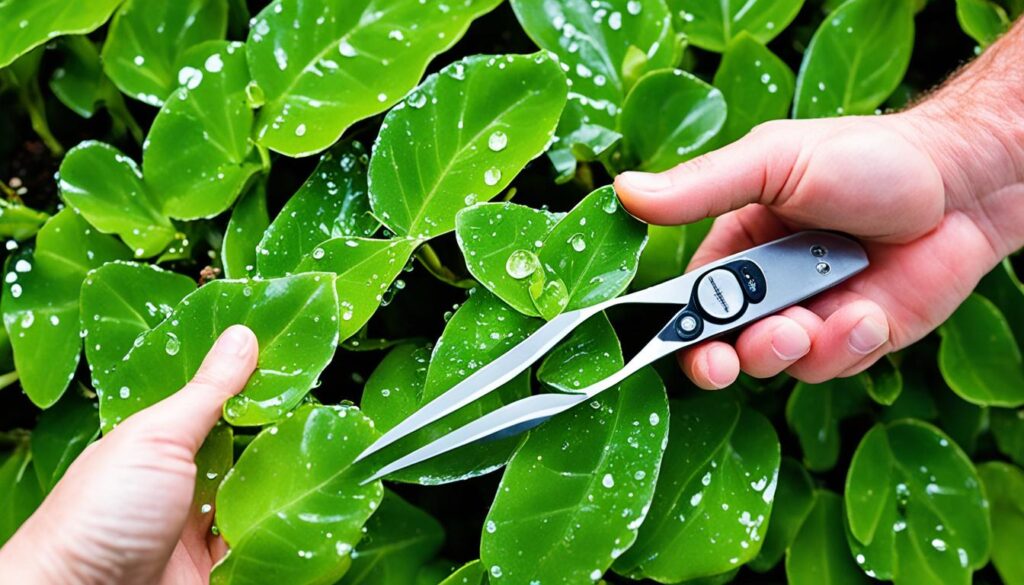
Trimming Carpeting Plants
Carpeting plants, such as Eleocharis and Glossostigma, play a crucial role in creating an attractive foreground in planted tanks. However, without proper maintenance, these plants can quickly become overgrown and hinder their own health. To ensure the longevity and vibrancy of your carpeting plants, regular trimming is essential.
By trimming carpeting plants, you prevent excessive growth that can lead to the lower portions of the plants rotting. Additionally, trimming encourages horizontal growth, maintaining a lush carpet-like appearance and preventing the plants from growing too tall and overshadowing other aquatic species in your tank.
To effectively trim carpeting plants, it is recommended to use specialized trimming scissors and cut all the upper shoots down to a few centimeters above the ground. This helps to maintain the desired height and encourages new growth from the base, resulting in a denser carpet.
Remember, carpeting plants are often delicate and require careful handling during trimming. Use precise and clean cuts to avoid damaging the plants or introducing potential infections.
Expert Tip: When trimming, it’s important to maintain a balance between removing excess growth and preserving the aesthetic appeal of your carpeting plants. Start by trimming smaller sections and observe how the plants respond over time. Adjust the frequency and intensity of trimming based on the plant’s growth rate and the desired carpet density.
Regular maintenance and trimming of carpeting plants will promote healthier growth, protect against potential issues that can arise from overgrowth, and maintain the visual appeal of your aquascape.
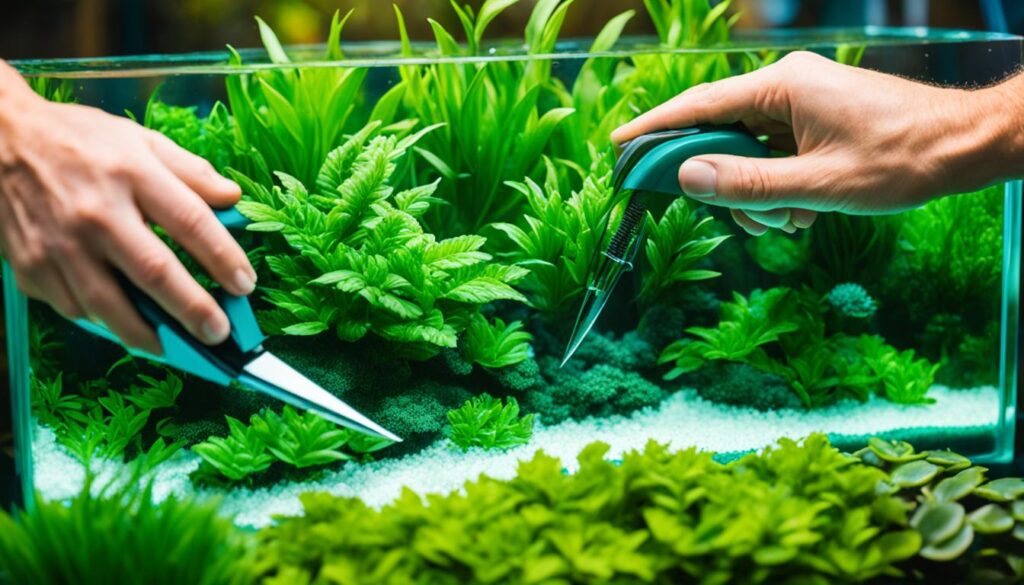
| Benefits of Regular Trimming for Carpeting Plants | How to Trim Carpeting Plants |
|---|---|
| 1. Prevents overgrowth and lower plant rot. | 1. Use specialized trimming scissors. |
| 2. Encourages horizontal growth for a lush carpet-like appearance. | 2. Cut all upper shoots a few centimeters above the ground. |
| 3. Maintains the desired height and prevents overshadowing. | 3. Make clean and precise cuts to avoid damage. |
| 4. Promotes new growth and denser carpets. | 4. Observe plant response and adjust trimming frequency. |
Maintenance Tips for Aquarium Plants
In addition to regular trimming, there are several care tips and best practices that can help maintain healthy aquarium plants.
Daily Tasks for Plant Maintenance
To keep your aquatic greenery thriving, it is important to incorporate these daily tasks into your plant care routine:
- Dose fertilizers: Providing the right nutrients is crucial for plant growth. Use a high-quality aquarium plant fertilizer and follow the recommended dosage instructions.
- Remove dead or decaying leaves: Regularly inspect your plants for any leaves that are dying or turning brown. Use a pair of aquarium scissors or tweezers to carefully remove these leaves to prevent decay.
- Check water temperature: Maintaining the appropriate water temperature is essential for the health of your aquarium plants. Ensure that the temperature remains within the optimal range for the specific plant species.
Proper Lighting and Fertilization
Lighting and fertilization play a crucial role in the growth and overall health of aquarium plants. Consider the following points:
- Provide adequate lighting: Different plants have varied lighting requirements. Research the specific lighting needs of your plants and invest in a high-quality aquarium light that supports their growth.
- Choose the right fertilizers: There are different types of aquarium plant fertilizers available, such as liquid, root tabs, or substrate additives. Select the appropriate fertilizer based on the needs of your plants and follow the instructions for application.
Compatibility with Fish and Invertebrates
When choosing fish or invertebrates to populate your aquarium, it is important to consider their compatibility with delicate plants. Some species may nibble on or uproot plants, causing damage. Ensure that you select fish and invertebrates that are known to be plant-friendly.
“Regular maintenance helps prevent issues like algae growth and ensures the overall health of the planted tank.”
By incorporating these care tips and best practices into your aquarium plant maintenance routine, you can ensure that your plants thrive and contribute to a vibrant and beautiful underwater environment.
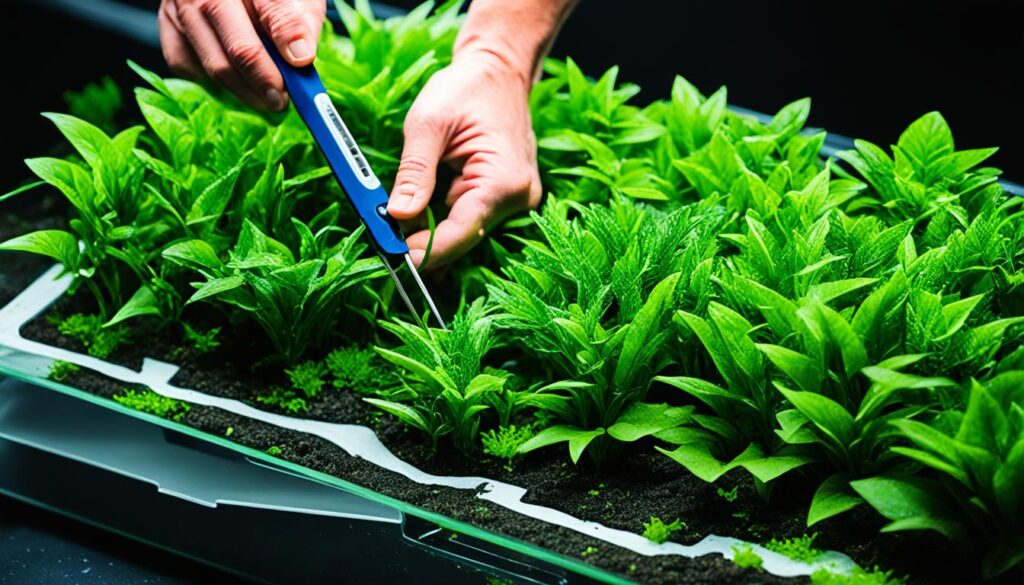
References
1. [Insert reference source]
| Plant Care Tips | Description |
|---|---|
| Dose fertilizers | Provide plants with essential nutrients |
| Remove dead or decaying leaves | Prevent decay and maintain plant health |
| Check water temperature | Maintain optimal temperature for plant growth |
| Provide adequate lighting | Meet the lighting requirements of different plant species |
| Choose the right fertilizers | Select appropriate fertilizers based on plant needs |
| Consider compatibility with fish and invertebrates | Avoid species that may damage plants |
Conclusion
In conclusion, maintaining a beautiful and thriving underwater garden can be achieved by mastering the art of trimming aquarium plants. By following the steps outlined in this aquascaping maintenance guide, you can confidently trim various types of aquatic plants, including rhizome plants, stem plants, mosses, bulb plants, rosette plants, and carpeting plants.
The best way to trim underwater plants is to assess the specific needs of each plant type and follow appropriate trimming techniques. Regular maintenance and proper care are crucial for ensuring the health and longevity of your aquatic greenery. By trimming unhealthy or overgrown vegetation, you promote new growth and maintain the aesthetic appeal of your aquarium.
Remember to remove any rotting leaves, trim the roots when necessary, and replant cuttings to propagate new plants. Additionally, it’s important to create a proactive maintenance routine that includes dosing fertilizers, removing dead leaves, and monitoring water temperature and lighting conditions. By doing so, you can prevent issues like algae growth and create an optimal environment for your aquatic plants to thrive.
FAQ
What are some essential steps to trim aquarium plants like a pro?
The essential steps to trim aquarium plants like a pro include understanding the different types of plants and their unique trimming needs, using sharp scissors or a razor blade for precise cuts, and removing any dead or unhealthy leaves to encourage new growth.
How do I trim rhizome plants in my aquarium?
When trimming rhizome plants, it is important to cut unhealthy or rotting leaves close to the rhizome to promote new growth. The roots can also be trimmed if they become overgrown or unsightly. Propagation can be done by cutting the rhizome with sharp scissors or a razor blade.
What is the best way to trim stem plants in my aquarium?
To trim stem plants, it is recommended to trim the longest shoots just above one of the bottom leaves. This encourages new lateral shoots to sprout from the trimmed stem. Always use sharp scissors for precise cuts and replant the cuttings to increase stem count and density.
How should I trim mosses in my aquarium?
Mosses can be shaped by cutting them with sharp scissors. It is important to turn off the filter and have a siphon ready to remove any loose fragments of moss after trimming. These fragments can be replanted by attaching them to the desired surface using black thread.
What are the recommended techniques for trimming bulb plants?
When trimming bulb plants, it is important to remove old or unhealthy leaves by cutting them as close to the base as possible. New leaves will emerge from the shoot tip of the bulb, not from the trimmed portion. Bulbs should not be divided as they contain vital organs necessary for the plant’s survival.
How should I trim rosette plants in my aquarium?
Trim damaged or rotting leaves of rosette plants by cutting the petiole (leaf stem) as low as possible. This redirects the plant’s energy to healthier leaves. Rosette plants can be propagated by cutting side shoots and replanting them.
What is the best way to trim carpeting plants in my aquarium?
To trim carpeting plants, cut all the upper shoots down to a few centimeters above the ground using specialized trimming scissors. Regular trimming prevents overgrowth and encourages horizontal growth. Avoid cutting too low to prevent damaging the root structure.
What are some maintenance tips for aquarium plants?
Daily tasks such as dosing fertilizers, removing dead or decaying leaves, and checking water temperature are essential for maintaining healthy aquarium plants. Proper lighting and fertilization, as well as avoiding mixing plant-eating fish or invertebrates with delicate plants, can also contribute to the overall health of your planted tank.
What is the importance of regularly trimming aquarium plants?
Regularly trimming aquarium plants is crucial for maintaining a beautiful and thriving underwater garden. Trimming removes dead or unhealthy parts of the plants, promotes new growth, prevents overgrowth and rotting, and maintains the overall health and aesthetics of the planted tank.
